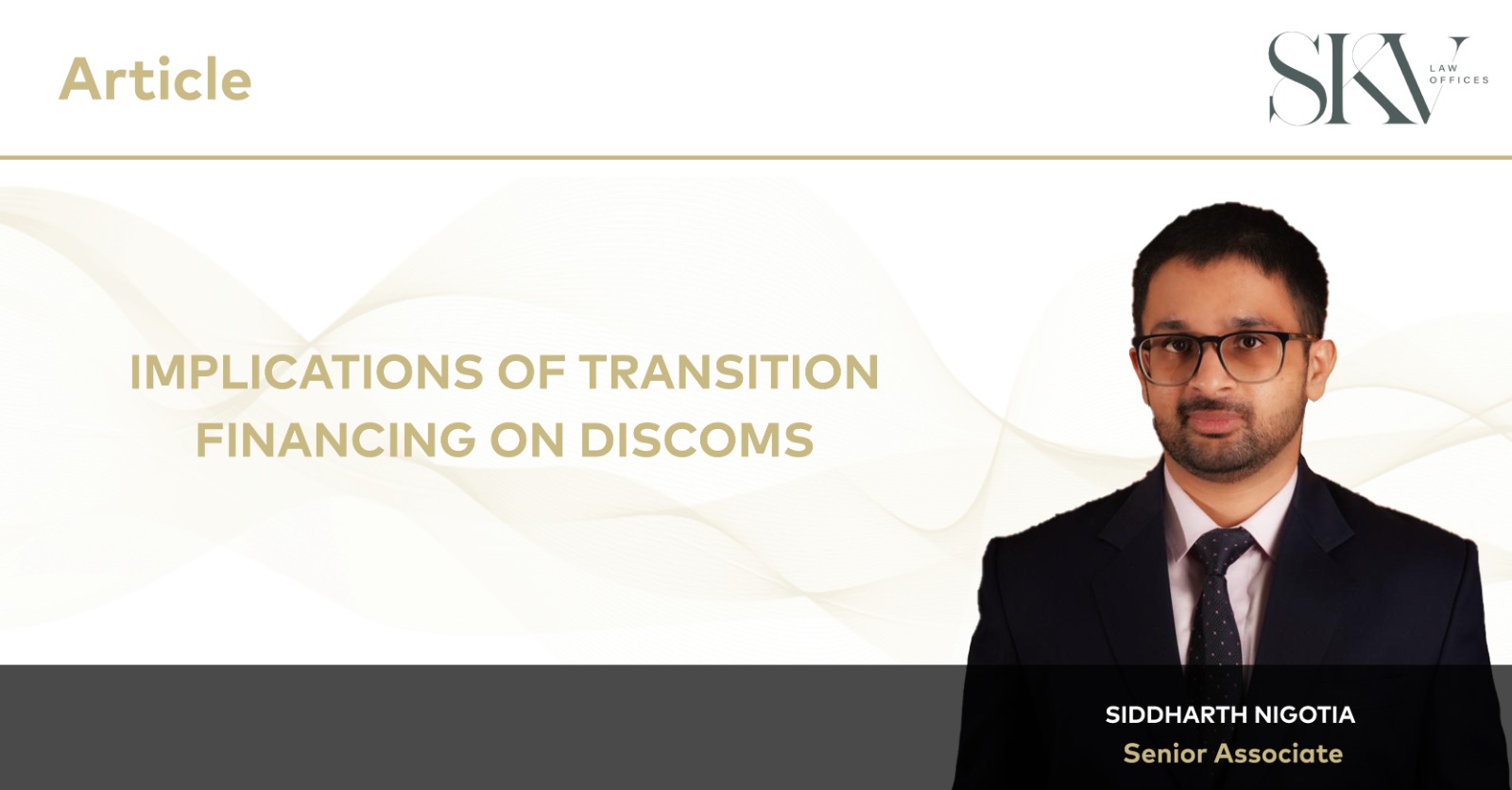Implications of Transition Financing On Discoms
08.07.2024
Authored by: Siddharth Nigotia, Senior Associate
INTRODUCTION
Government of India (“GoI”) has set an impressive goal towards renewable energy. One of its stated aim is to achieve a total capacity of 500 Gigawatts (“GW”) of renewable energy by 2030. With a capacity of 500 GW, India aims to have 50% of total electricity generation to come from non-fossil fuel sources by 2030. To put things in perspective, as of May 2024, the total installed renewable energy capacity was approximately 190 GW and is growing at a rapid pace. It will not be incorrect to say that GoI intends to leave no stone unturned towards development of its renewable energy sector.
In its endeavour to achieve such an ambitious goal, GoI has undertaken various policy and legislative decisions. For instance, major announcements for solar rooftop subsidy were made by the GoI during the interim budget announced in 2024. It is widely expected that GoI will continue with such policy decisions to promote and achieve the aim of 500 GW.
Now, such an ambitious goal with concomitant policy (and legislative) changes shall have sectoral implications. India presently heavily relies on fossil fuels to fulfil its energy requirement. Therefore, achieving a goal of 500 MW of renewable energy shall entail major shift in the power sector and all its stakeholders.
Considering that setting up of renewable energy shall involve significant capital expenditure, the GoI shall have to make appropriate policy (and legislative) decisions to aid (as well as regulate) financing of capital. In sectoral parlance, financial mechanisms aimed at aiding the transition from conventional energy sources to renewable energy sources have been termed as ‘Transition Financing’. Amongst various stakeholders, the present article explores the impact of transition financing on distribution companies (“DISCOM”) in India. Naturally, transition financing shall have varied impact on the DISCOMs, including financial and regulatory impact as well as operational & technical impact.
IMPLICATIONS OF TRANSITION FINANCING
- Financial implications and considerations for DISCOMS
In order to achieve such significant capacity addition in renewable energy, it is clear that the DISCOMs will have to invest in improving infrastructure, integrating renewable energy sources, and enhance grid reliability. As such, it is evident that DISCOMs shall require substantial upfront capital investment. Therefore, ease of access to transition financing can help mitigate the burden of these capital requirements by providing low-interest loans, grants, and subsidies.
Moreover, ease of access to financing can enhance the financial stability of DISCOMs. If DISCOMs are enabled to secure funds dedicated to transition projects, DISCOMs will be able to efficiently manage their cash flows and avoid the risk of insolvency, which otherwise persists as a sectoral problem. In this context, it must also be stated that in power sector, DISCOMs often face problem of huge outstanding debts. In fact, DISCOMs have faced this issue persistently. Thus, transition financing assumes significant importance particularly for DISCOMs.
- Operational Implications and considerations for DISCOMS
Presently, the energy production in India is heavily dependent upon fossil fuels. As such, the power infrastructure has been designed to operate accordingly. However, with eventual increase in energy production from renewable resources, changes shall have to be made to the existing power infrastructure, which includes infrastructure of DISCOMs as well. Therefore, transition financing shall play a key role for DISCOMs to modernize their infrastructure. In addition, needless to state, if transition financing is provided to DISCOMs, they will be able to achieve improve operational efficiency.
It must also be borne in mind that, unlike fossil fuels, power from renewable sources is intermittent and unreliable. Addition in capacity of renewable resources shall also require that adequate infrastructure is put in place to ensure reliability of power supply. Once again, transition financing shall play an important role in aiding development of such infrastructure.
- Regulatory Implications and considerations for DISCOMS
As stated earlier, GOI has introduced policy and legislative changes in order to ensure that it is able to meet its target of capacity addition of renewable resources. Now, in order to ensure capacity addition, necessary prescriptions in law shall be have to be imposed on all stakeholders, including DISCOMs. For instance, various States have introduced Renewable Purchase Obligations (“RPO”) wherein DISCOMs are mandated to purchase minimum prescribed power from renewable resources. Moreover, renewable resources also enjoy ‘must run’ status and are prioritized over other sources of energy. In addition, it is evident that failure to comply with such prescriptions will entail punitive measures. As such, transition financing is necessary to enable DISCOMs to comply with the law and policy changes.
CONCLUSION
It is now clear and established that the GOI, and even governments across globe, are making incremental efforts to develop and expand renewable energy sources. In India, the Government hopes and aims to achieve significant capacity addition by 2030. In order to ensure such huge capacity addition of renewable power, it is necessary to put in place necessary infrastructure which requires significant capital expenditure.
As the name suggests, transition financing shall facilitate the stakeholders, including DISCOMs, to invest in necessary infrastructure. Moreover, it is evident that in order to ensure such capacity addition, necessary legislative changes have been made and will be continued to be made. DISCOMs will have to necessarily comply with such regulatory requirements. Thus, transition financing shall be required to aid DISCOMs to ensure capacity addition. Lastly, transition financing shall be also be required to enable DISCOMs to ensure financial stability, technological development etc.


